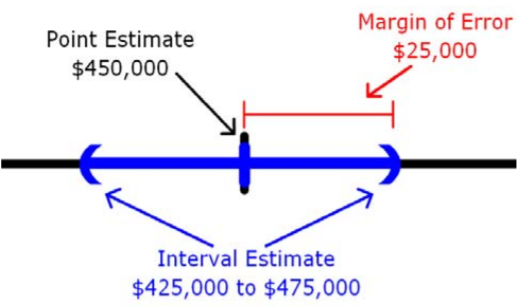9.2: Estimación de puntos
- Page ID
- 151465
El ejemplo en 9.1 es un ejemplo de Estimación, una rama de Estadística Inferencial en la que se utilizan estadísticas de muestra para estimar los valores de un parámetro de población. El agente inmobiliario de Lupe estaba tratando de estimar la media poblacional (\(\mu\)) con base en la media muestral (\(\overline{X}\)).

En el ejemplo anterior, el agente inmobiliario de Lupe estimó la media poblacional de viviendas similares en el barrio de Lupe utilizando la media muestral de $450,000 a partir del precio ajustado de las viviendas muestreadas.
Estimación de Intervalos
Una estimación puntual es nuestra “mejor” estimación de un parámetro de población, pero lo más probable es que no sea exactamente igual al parámetro. En su lugar, elegiremos un rango de valores llamado Estimación de intervalo, que probablemente incluya el valor del parámetro de población.
Si la Estimación de Intervalo es simétrica, la distancia desde el Estimador de Punto a cualquiera de los puntos finales de la Estimación de Intervalo se denomina Margen de Error.

En el ejemplo anterior, el agente inmobiliario de Lupe podría en cambio decir que la verdadera media poblacional es probablemente entre $425,000 y $475,000, lo que permite un Margen de Error de $25,000 a partir de la estimación original de $450,000. Esta estimación de Intervalo también podría reportarse como $450,000\(\pm\) $25,000.


